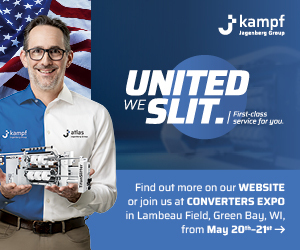1960s
- Published: September 20, 2002, By PFFC Staff
1920s and 1930s
1940s
1950s
1970 - 1973
1974 - 1976
1977 - 1979
1980s
1990 - April 1993
May 1993 - 1994
1995 - 1999
2000 to present
The 1960s...
Russia becomes the enemy as the Cold War heats up. America goes to war in Vietnam, and Neil Armstrong goes to the moon. Martin Luther King Jr. has a dream, and the music world has a “British Invasion.” Civil rights triumph, but the sixties bring more than “flower power.” By the time they end, John Kennedy, Bobby Kennedy, and Martin Luther King Jr. have been assassinated.
November 1960
Richard Nixon loses the presidential election to John F. Kennedy, the youngest man ever to be elected president. This is the first national election in which television plays a major role.
January 1961
The “Bax” is introduced, a new hybrid container developed by St. Regis Paper Co., which incorporates the features of both a bag and a box.
Paris is home to Autopac, the first international packaging show. The French Packaging Institute sponsored what made up the First International Packaging Machinery Exhibition.
March 1961
A unique laminating system called "Daponite" is introduced by Food Machinery and Chemical Corp. for the use of furniture and panelboard producers. Papers are impregnated with a plastic (diallyl phthalate) resin to produce a tough plastic laminate on almost any kind of flat surface when subjected to heat and pressure.
Dr. Willy Ley, space scientist, calls the future of space exploration “a packaging problem.” Comparing the protections of commercial packaging with those provided to an astronaut, he says that in both cases the chief concern was controlling the internal environment.
April 1961
To thwart the threat of Communism, Cuban rebels backed by the U.S. attempt to overthrow Fidel Castro in an event known as the "Bay of Pigs." Its failure was a horrible embarrassment to the young, new president who let it proceed.
Chicago’s McCormick place opens, and the first convention held there is American Management Assn.’s 30th National Packaging Exposition.
May 1961
Alan Shepard becomes the first American to fly in space.
August 1961
Russian Premier Khruschev exerts his country’s authority in Europe by building the Berlin Wall.
September 1961
Tetra Pak presents the first aseptic filling machine for bacteria-free milk at a press conference in Switzerland.
October 1961
Fitchburg Paper Co. makes plans to attempt the use of atomic power in paper production.
November 1961
The very first plastic film pouch with a built-in drinking straw is introduced. Dubbed a "Siptainer," the straw is permanently sealed to the inside of the package. A variation of the pouch called the "Flavor-Flute," allows different flavors to be sipped from different compartments with a fluted edge.
February 1962
Rainbow trout is packed individually in colorfully printed PE bags.
April 1962
Frozen lemonade is packaged with a new look that will be produced even in today’s brands of popsicles.
August 1962
The National Guard is called out to oversee the integration of the University of Mississippi as James Meredith became the first black to enroll.
September 1962
Although the Iron Curtain hangs over Europe, a packaging conference was held in Budapest. Packaging specialists from western and eastern countries (including Russia) met to discuss problems and exchange ideas.
October 1962
The newest innovation in cellophane-wrapped bread, developed by DuPont, is a pressure-sensitive end label, which retains its tackiness through constant re-sealing.
Women’s swimsuits are packaged in tubes. Meant to sit on counters, producers hoped the package design would stimulate impulse buying.
December 1962
An eastern firm introduces the first rolls of toilet paper printed with patterns as well as color.
Several European converters discover a method of mounting flexographic plates without adhesive. They find that by using magnetics, the method costs more but also saves time for mounting rubber plates.
February 1963
The world expects a revolutionary white paper that will eliminate the need for carbon paper, ribbons, and ink in machine recording to make substantial changes in business machines and office paperwork industries.
June 1963
New one-piece aluminum foil angel food cake pans are introduced, replacing the previous usage of paperboard pans.
August 1963
Candy makers make use of a new glassine tray with individual cups for candy pieces.
In 1963, Tetra Pak launches its Tetra Brik package in Sweden.
September 1963
Australians host their First Graphic Arts and Packaging Exhibition at Sydney in New South Wales.
October 1963
London hospitals begin to use disposable paper products. Uniforms and blankets are paper, and thrown away use, as is similarly done with plastic plates and utensils, all of which lead to better sanitary conditions, as well as cost-reduction in laundry bills.
December 1963
Potato chips are packaged in cellophane due to new advancement in the industry.
In a step toward pre-packaging produce, celery hearts are bagged for the first time.
January 1964
Disposable surgical drapes now are standard equipment on the hospital ship, S.S. Hope, instead of linen drapes.
March 1964
President Joe Peacock promotes Vernon A. Prescott to editor and publisher.
May 1964
Wedge-shaped PE bags with interlacing slits on one face are adopted to package grapes.
July 1964
Plastic containers are rated as superior for packaging cottage cheese, determines a consumer survey. The survey was comprised entirely of women.
March 1965
The Graphic Arts Technical Institute in East Germany developed a method of viscosity control for gravure printing inks at high press speeds to reduce danger of explosion.
Planes bomb Vietnam in a heavy aerial assault.
Tear strips for opening corrugated shipping containers are introduced by Waldorf Paper Products, eliminating the use of sharp objects for carton opening.
April 1965
Companies begin to mount china and glassware in board before packaging, and in doing so decrease breakage and improve shipping and handling.
May 1965
Film finds a place in space as a package for food consumed by Gemini astronauts.
Companies discover that the insertion of an aluminum foil cup in each nest of baking cups solves the problem of out-of-shape cups, and begins to market this innovation.
June 1965
Congress authorizes the use of ground troops in Vietnam, and a complete ground offensive is underway.
July 1965
America decides to make readily available standardized sizes for envelopes. Trials of a nationwide postal coding system are to be tested later in the year.
August 1965
A carrier for soft drink bottles is introduced by Olin Mathieson Chemical Corp. The carrier incorporates a central keel with a full bottom strip that separates bottles, along with middle separators for bottle shoulder protection.
The Voting Rights Act becomes law, ensuring the voting rights of African Americans nationwide.
October 1965
Allen Ginsburg introduces the term “flower power” to define a protest strategy.
February 1966
Industry believes that paper foil should be used in vegetable gardens to reduce plant losses by insects.
CPS Industries develops a special pre-sized, pre-decorated gift wrapping sleeve. The sleeve is self-sealing through use of pressure sensitive strips on the sleeve ends and sides. Wrappings come with banding ribbon and a pre-made bow.
May 1966
Small, individual, tube-shaped packages are introduced for sampling use of drugs, cosmetics, and other liquids.
June 1966
Reynolds Metals develops the first use of a laminated aluminum foil liner in breakfast cereals, still employed by many brands today to seal in freshness and flavor.
The Supreme Court issues its “Miranda” ruling, which dictates that suspects must be told that they have a right to legal counsel and that they do not have to answer police questions.
October 1966
A new logo is introduced.
Unit packages, previously manufactured only as a convenience item, is gaining a stronghold in the flexible packaging of cosmetics and pharmaceuticals.
November 1966
Cotton swabs now are available pre-saturated with antiseptics and packed in convenience-oriented high density PE pouches, eliminating most of the steps previously needed to apply such solutions.
January 1967
The Green Bay Packers beat Kansas City in the first Super Bowl.
A patent for electrostatic powder gravure printing development was awarded to Interchemical Corp. The patent covers a process for gravure printing with the aid of electrostatic forces, using powder as the printing material, and also the apparatus for carrying out the printing process.
Three U.S. astronauts (Grissom, Chaffee, White) die in a fire on the launch pad during a practice session of what would have been the first Apollo mission, dubbed Apollo I after the tragedy.
April 1967
We run our first four-color cover.
Eli Lily & Co. introduces a packaging and labeling system in which drugs are packaged by individual dose in an airtight plastic bubble backed by a paper/foil laminate bearing a label with the medicine’s name.
May 1967
Surge of industrialization in Latin America is reflected by the successful start-up of a flexible packaging converter, Rotoflex S.A. in El Salvador, Central America.
Stringent sterility requirements, such as in the packaging of sterile hospital supplies, become available in peel-open packages from 3M.
July 1967
A brand of facial tissues are marketed in special dispensers that double as toys with a choice of cut-out wild animals, circus trains, or clowns printed in full-color.
August 1967
Fair Packaging and Labeling Act bill date is pushed back with revised rules. December 31, 1967, is now the effective date for all new packaging and new label designs as well as reordered labels and packages. July 1, 1968, is the date for all other food product packaging. The bill demands labels eliminate descriptive words (such as jumbo, giant, etc.), include the form of the product (diced, sliced, etc.) in the name, and list the net weight in ounces.
September 1967
Sealed plastic bags help to fulfill an important requirement in the manufacture of missile system components.
January 1968
Described as a new concept in table coverings, opaque, lightweight PE is printed in various colors and patterns and embossed for a linen-like finish, producing disposable, but reusable, tablecloths for a cheaper price and easier clean-up.
April 1968
Dr. Martin Luther King is assassinated in Memphis Tennessee.
May 1968
Carton converters hold the first meeting of the Paperboard Packaging Council, deeming it a most successful convention.
June 1968
The rapid expansion of the disposable soft goods marketplace leads to the formation of a Disposables Association, later dubbed the Assn. of the Nonwovens Fabrics Industry (INDA).
National Paperbox Assn. celebrates its 50th anniversary.
July 1968
A breakthrough in papermaking technology from Black Clawson’s Verti-Forma paper machine. A vertical forming unit offers an improved product at higher speeds and lower initial investment.
September 1968
The World Packaging Organization nears reality as global support for its formation is received and a January 1, 1969, date set to begin operation.
November 1968
Richard Nixon wins the presidency in a close race against Hubert Humphrey.
December 1968
The retortable “wetpack,” developed by Continental Can Co., is used to contain the turkey dinner eaten by the Apollo 8 crew while circling the moon.
January 1969
Robert W. Heitzman, who joined the staff as new products editor in 1962 and served as field editor and managing editor, is named editor of the magazine. Vernon Prescott is publisher.
July 1969
First US built milk pouch packaging machine is introduced by Hayssen Mfg. A refinement of a similar Canadian model, the flexible pouch filling system reduces foaming, seals strong, and provides a drip-free operation.
The Disposables Assn. holds its first meeting, reporting success.
August 1969
Scarlet-colored nonwoven gowns, with matching beanies for girls, made their debut at a Long Island confirmation ceremony. The Avisco rayon nonwoven fabric is called “Fabray.”
Half a million party-goers sludge through the mud to experience four days of rock n’ roll at Woodstock.
Flexible packaging lands on the moon in the form of film/foil pouches developed for turkey, ham, and beef dinners taken on the Apollo 11 voyage.











